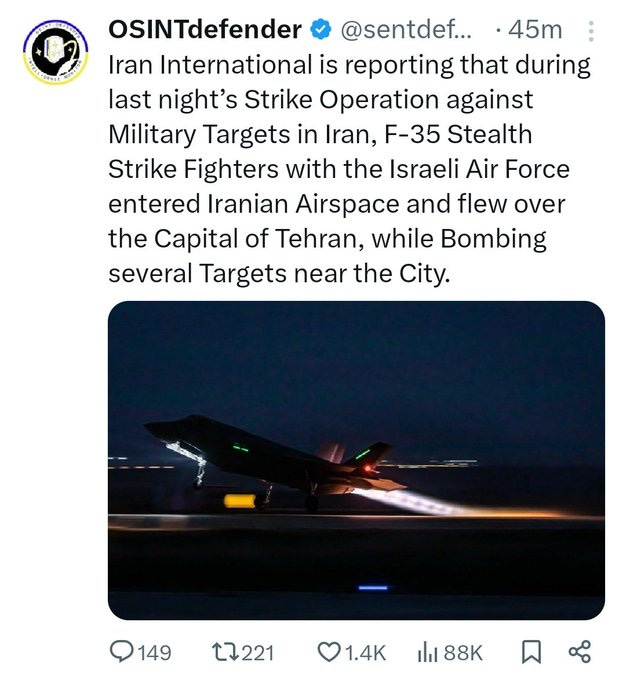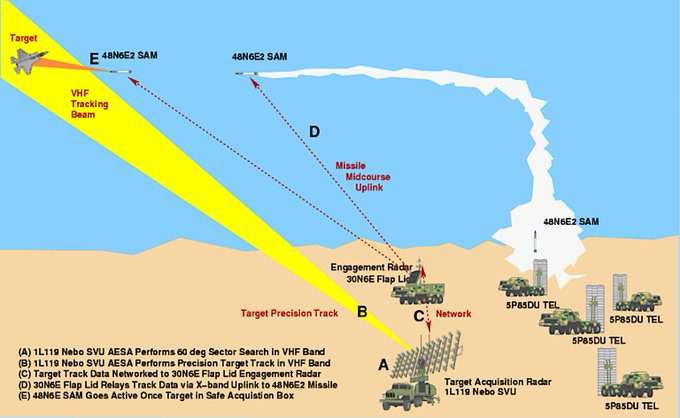Everyone who’s in the know is talking SEAD today—Suppression of Enemy Air Defenses. And the US and Israel are very blue, according to these people, who I’ll be quoting. This comes in the context of the usual Zio-prop that’s being put out for our amusement—Iran International is based in London.
Canadian Prepper @PrepperCanadian
The sheer amount of falsehoods and damage control on IDF accounts right now is embarrassing to watch.
Larry Johnson offers another good example today—including some amusing contrasting before/after talking points. Some Zio-fanboy, when word gets out that the big, surprising, painful Israeli super strike has begun, is wetting his pants: Wow, we’re suppressing the Iranian AD, next come the nukes! Afterwards, the same guy is like, Oh, well, we were sending a message. But what’s important is that you see the 2 step process: SEAD, then the major strike.
That’s the kind of stuff we’ll be addressing. Expertise of various sources may vary. Still, it makes sense to me.
First of all, recall that I quoted Will Schryver in the immediate aftermath. This is a key observation, as you’ll see as we progress:
Will Schryver @imetatronink
It increasingly appears as though the underwhelming Israeli strike on Iran suffered a "major hitch" rather early in the operation.
Quote
Will Schryver @imetatronink
Oct 14
Israel Says It Will Sally Forth Boldly
Now they just have to hope the Iranians et al. aren't impudent enough to shoot back.
If Israel seriously attempts a major long-range strike, I will be shocked if they can pull it off without a major hitch.
https://washingtonpost.com/world/2024/10/14/israel-iran-strike-nuclear-oil-military/…
8:25 PM · Oct 26, 2024
I should add right up front, somewhat parenthetically, that Will also takes out after the Iranian guy I have quoted extensively: Patarames @Pataramesh:
In my view, you have entirely destroyed your credibility over the past two days. I don't understand your motivations, but I will never again trust anything you say.
This has to do with Patarames displaying aerial photos of damage to an Iranian site that Will and others dispute. For my part, I still believe Patarames had a shrewd bottom line—that the real takeaway is that Israel can do no major harm to Iran short of nukes, whereas Iran can disarm Israel using conventional weapons. We’ll get back that near the end.
Anyway.
Schryver also quotes another poster—but follow the link for many more examples—to suggest what at least one “major hitch” turned out to be:
Filippo Neri @FilippoNer97498
'Israeli media reports that an "unknown air defense system" was used to shoot down targets over Tehran province.'
This system is possibly the 48N6E2(3) missile that Iran's S-300 (or S-400) launchers could use.
The 48N6E2 (48N6D) has a range of 200 km and a speed of Mach 6.5.
The 48N6E3 (48N6DM) has a range of 250 km—speed Mach 7+.
I have argued that Russia developed anti-stealth versions of these missiles.
6:41 PM · Oct 26, 2024
AD missiles that can defeat stealth tech would definitely be a nasty surprise, well able to cause a “major hitch.” Follow the next link for additional illustrations:
Filippo Neri @FilippoNer97498
Anti-stealth defense.
VHF radars can detect and track stealth planes, but not accurately enough to guide missiles into them.
So, a missile with a terminal guidance system that allows it to home on the stealth plane, if it is guided to a position close enough to it, has to be used.
This missile, for Russia, is almost certainly a version of the 48N6 (possibly the 48N6DM). The 48N6 is about 7.5 m long, has a diameter of 0.519 m, and weighs 1.835 kg. The range is 200+ km.
The missile has inertial navigation to head toward the target and can receive mid-course corrections.
It would probably use active radar or infrared in the terminal phase.
That should explain why the Israeli planes apparently didn’t attempt to enter Iranian air space but, instead, unloaded at long range. Which translated into an ineffective strike. But those speacialized Russian systems were probably only available on a limited basis. Other advanced missiles, like the S-300/400, were undoubtedly also used. They key is the radar.
Now let’s get more technical with Simplicius. Simplicius explains why SEAD doesn’t work at long ranges, and why “Israel is not capable of conducting real SEAD against Iran.”
SIMPLICIUS Ѱ @simpatico771
It's amusing to see the spate of amateurs who so pretentiously proclaim Israel conducted some sort of highfalutin "SEAD" mission against Iran, destroying AD units like the S-300. These are delusions of grandeur.
Anyone who thinks that happened has no clue what SEAD even is or how it works. Go back to WarThunder and leave the analysis for the experts.
First of all, you don't do SEAD at 500-700km distance. SEAD typically requires the launching aircraft to first detect the air defense assets itself in order to directly lock-on the appropriate anti-radiation munition to that asset in real-time. That means you have to be within range to even detect an AD unit, which is certainly not feasible at the distances Israel timidly launched its ALBMs. That's because if you can detect them that means they can detect you.
Secondly, you have to have munitions even capable of doing SEAD, which most of Israel's long range ones certainly are not; Air Lora, Blue Sparrow, etc., these are GPS guided and are basically fired blind at a static target you think was there hours ago. Don't kid yourself amateurs, that's not SEAD.
Now the ROCKS allegedly has a rarer version capable of anti-radiation lock-on. The problem is, you're still not locking the target yourself as the delivery aircraft because at ballistic missile standoff ranges, the IAF is launching these ROCKS first with GPS coordinates based on where they "think" Iranian AD may be located, and then "hoping" that the terminal anti-radiation component takes over in the end, if it happens to detect some radiation.
That's hardly real SEAD as the delivery aircraft never identifies nor locks the AD directly itself, given that it's 500-700km away. You're basically blindly firing a ballistic missile at a static GPS coordinate (where your satellite saw an AD system located perhaps hours, perhaps days ago) and you're hoping some radiation signal is detected there.
That's not true SEAD by a long shot, it's just blindly flinging primitive GPS ballistics and hoping to hit mobile, relocatable targets.
Israel is not capable of conducting real SEAD against Iran because it would require Wild Weasel aircraft to actually get within detection range at which point they would be shot down.
This is very, very bad news—not just for Israel but for the entire Anglo-Zionist Empire. The US has invested uncountable billions—literally, because Pentagon “accounting methods”—in stealth technology. That’s what’s supposed to enable us to wage war anywhere, any time, without suffering catastrophic losses. The ability to safely penetrate secured air space. If all that investment in stealth is for naught, well, …
We knew Russia had top of the class AD capabilities. Now we’re learning that Russia is committed enough to BRICS that they’re sharing some of that with Iran (and maybe China?). Armchair Warlord gets into some of this. Note how his reasoning appears to be a development of Will Schryver’s take. Both are arguing that Israel really did intend a major strike—after all, over a hundred planes, something like 200 missiles launched? That’s some serious intentions. So:
Armchair Warlord @ArmchairW
I suspect that what actually happened in Iran last night was an aborted attack. The IAF's initial SEAD strikes with long-range missiles, meant to pave the way for what was probably an F-35 strike package with conventional bombs, clearly failed. Thus they scrubbed the strike.
Claims of damage in Iran beyond an apparent MIM-23 HAWK site in the Tehran area (which I suspect burned down due to a launch accident with very old missiles rather than enemy action) are very speculative at this point. Apparently four Iranian soldiers were killed during the attack, but the circumstances of their deaths - or, indeed, whether they were even in Iran or instead stationed in Syria, which was also hit last night - are unclear at this time.
BrOSINT is frantically searching around for anything that can be passed off as damage right now - the below pictures are claimed as destroyed buildings at an Iranian military facility when it rather looks to me like the Iranians put up some camouflage nets after the attack and brOSINT is grasping at straws, similarly to the claimed "damaged radar" from April.
In general this attack was extremely underwhelming, particularly given that the Israeli military has announced that (1) this was in fact the big retaliatory strike; and (2) they've finished the operation. It's difficult to escape the impression that this was either a monumental and very uncharacteristic flinch on Netanyahu's part or that the Israelis simply failed last night.
Johanna deMartin @OnlyRealJohanna
If it is an aborted attack because the SEAD failed, this is arguably potentially a worse security failure on Israel's part than their internal October 7 narrative.
It would demonstrate that the IAF can't actually hit Iran in any significant way without flying manned aircraft "downtown," likely because their stock of real standoff weapons is very low.
And that the F-35 is a failed design, because this was precisely what it was designed for.
Seal of the Apocalypse @SealOfTheEnd:
>And that the F-35 is a failed design, because this was precisely what it was designed for.
Was this: penetrating secured airspace, something they really promised, or was that only a promise related to B-2, B-21 ?
Armchair Warlord @ArmchairW:
Without looking up Lockheed's sales materials, I suspect it's what the Israelis bought them for!
If Iranian air space is secured air space, in whole or in any significant part, anything short of nuclear war is basically off the table, because Iran has overwhelming conventional force to wield in response.






SIMPLICIUS Ѱ @simpatico771
·
Oct 26
As expected, Israeli boosters were found in Iraq and Syria, from where the IDF exclusively launches their attacks on Iran. **The IDF planes do not dare go anywhere within 100-200km of Iranian border because even the F-35s are easily detected by Iranian/Russian radars**
Megatron @Megatron_ron
JUST IN:
 Aytollah Khamenei ordered the army to prepare for retaliating against Israel
Iran's Supreme Leader, Ayatollah Khamenei, has instructed the military to prepare a response 'as they see fit' – he said Iran must 'take the initiative', and show the enemy its power and resolve